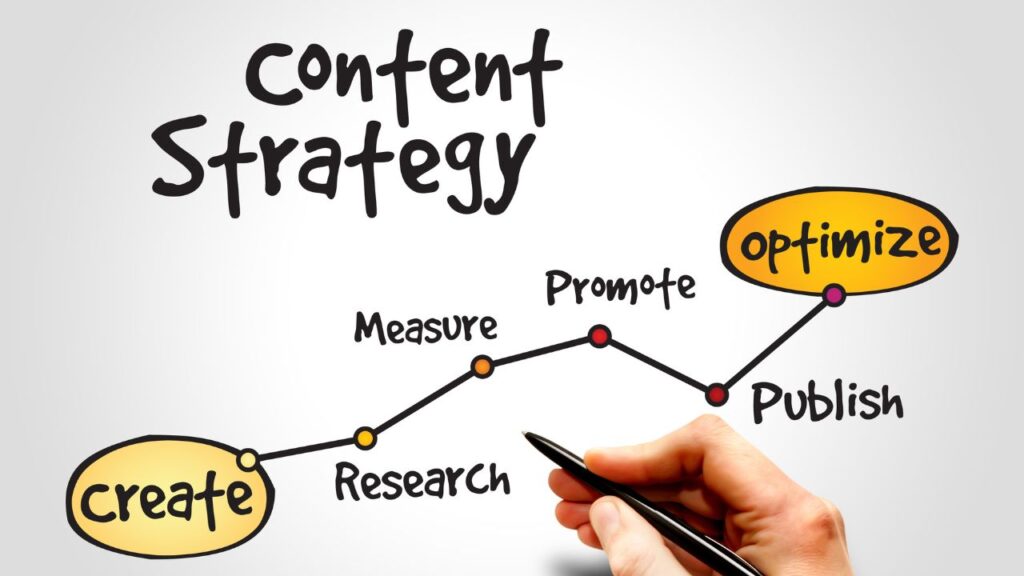Content marketing is one of the most popular inbound marketing strategies of recent times. However, most companies, especially small businesses and startups struggle to reap the benefits of content marketing due to inefficient strategies.

A company needs to ask the right questions before developing a killer content strategy and generate a solid framework to gain the most benefits from content marketing. Here we will discuss what questions to ask while generating a content strategy and how a company can develop a solid content strategy framework.
Why do Businesses Need a Solid Content Strategy?
Content marketing helps businesses to reach their audience more effectively. Companies can educate their customers and generate a strong brand presence with appropriate content. Thus, businesses can establish a strong authority over their competitors.
With a consistent content strategy, businesses can build a strong relationship with their audience to stay on top of their audience’s minds. Thus, when consumers are looking for a product or service, they know which business to turn to and purchase from them. Thus, the conversion rate of a business increases significantly.
As content marketing builds a solid relationship with the target audience, these audiences can attract new prospects to the business. Therefore, businesses will be able to spend less time reaching out to new customers and spend that time nurturing new ones.
In a nutshell, a good content strategy helps businesses to enhance their brand image, attract better leads, and generate better conversion rates.
All three of these factors play crucial roles in the growth of a business. Therefore, every business should have a solid content strategy.
Questions to Answer While Building a Content Strategy
As mentioned above, a solid content strategy helps attract and delight buyers to go through the sales funnel and enhance the brand image of a business. Recently 70% of marketers are investing in this inbound marketing strategy to increase sales and satisfy their consumers.
However, developing a killer content strategy requires asking the following crucial questions and having specific answers:
Who is the Audience of Your Content?
Before anything else, companies need to point out their audience for the content they are going to publish. Also, a rough idea about the size of the audience is crucial to determine in this stage.
A business can have more than one kind of consumer. Thus, the content strategy needs to be appropriate for more than one type of audience.
Businesses can utilize multiple channels to reach their target audience. Also, they will need to personalize the content for each persona.
Learn how to reach a global audience as well as provide your business with the stepping stones it requires to thrive and expand. Continue reading to learn the top ten ways to get there.
What are the Problems and the Solutions for the Targeted Audience?
Consumers only buy products that solve their problems. Businesses will need to generate content where the problems of the consumers and how those problems can be solved are mentioned clearly.
Good content can educate the audience about the problems they face and explain how they can address them. Therefore, good content will need to support audiences still figuring out their problems and already using their products.
When a business publishes content that reinforces unique solutions, it helps in building credibility with the audience.
What are the Reasons for Choosing a Specific Business?
Hundreds if not thousands of businesses are conducted online with similar products. Also, consumers are now more informed about different products and services to choose from the best. Thus, a business needs to stand out from the competition to generate a better bottom line.
Businesses need to figure out what makes them unique from others and generate content. These unique factors will help businesses to stand out from the competition and make the audience listen to what they have to say.
Companies communicate with their audience through content. Once the audience finds proper value from content and can relate it to their concern, they will be more likely to choose that business over similar ones.
What Content Formats to Use?
There are several content formats used by businesses, and they work for different audiences and situations. While some content may seem more tempting, businesses must choose content that resonates with their audience and where their audience usually hangs out.
If businesses choose the content format based on popularity rather than the audience’s requirements, it will not reach maximum potential consumers. Therefore, the content will fail to get the target audience’s attention and fail miserably.
Once businesses have chosen their content format, they will need to generate a budget to assess the resources they can allocate to execute their content strategy.
What Content Publishing Channel to Utilize?
There are several channels to publish content. Businesses must find the best publishing channel to gain top-notch benefits from their content marketing strategy.
To understand the best channel to publish content, businesses must find where most of their audience spends time. For example, if businesses sell technical products and services, they will need to target Youtube, where they can publish “How to” guides to help their audience. For beauty products, Instagram and Tiktok can be excellent platforms.
How to Manage Content Creation and Publication Process?
Lastly, business owners will need to figure out how they can manage the content creation and publication process. First of all, they need to establish the following factors:
- Who is creating what type of content?
- Where will the content be published?
- When will the content be published?
For small businesses tracking these factors may be easy. However, businesses collaborating with a large team will need to dedicate an effective system to keep track of all these metrics.
How to Build an Effective Content Marketing Strategy?

Once a business has figured out the above-mentioned questions, generating a solid content strategy becomes easier. Here are 7 steps to building a successful content marketing strategy:
1. Define the Content Goal
The first step to developing a killer content strategy is generating specific content marketing goals. As content marketing can help businesses with multiple benefits, businesses can get distracted from their primary objective without a solid goal.
Having solid goals can help businesses reach their destination faster and effectively. They will also have an easier time developing their content strategy in this manner.
2. Setting The Right KPIs
Key performance indicators help businesses to track the success of their marketing efforts. These measurable metrics show if the strategy is working or not.
When a strategy is set, some parts of it can work exceptionally, and some may fail. Therefore, businesses will need to reevaluate their strategies where it is not working and nurture successful ones.
Here are 7 crucial KPIs content marketing should have.
- The number of content publishers: businesses will need to find a good balance of content they are publishing. Too little may not attract much attention; too much can overwhelm the audience.
- Organic traffic: This is one of the important KPIs. The primary goal of a content strategy is to generate organic traffic. If businesses are not getting enough organic traffic, they may need to reevaluate their content strategy.
- Traffic-to-sales ratio: Getting traffic to a website may not be useful if enough sales are not generated. Make sure to generate content that influences the visitors to conduct a desired action.
- Sales generated by inbound marketing: This is one of the KPIs that most businesses utilize. Here, businesses calculate how many new sales opportunities have been created due to the content strategy.
- Average sales cycle rate: This KPI indicates the rate of closed sales within a certain time. Here the content marketing and sales team need to collaborate to convert leads into customers.
- Keyword ranking: With better content, the search engine ranking of a website improves. This can be an important KPI to measure the success of your content marketing efforts.
- Sales generated by content marketing: This KPI measures how much sales have increased as a direct result of content strategies that are utilized. This information can be used to find out the exact dollar value of a piece of content.
3. Generate a Detailed Persona
Once content goals are established, businesses can now focus on developing a detailed avatar of their target audience. A detailed avatar can help businesses relevant and valuable content for their audience. This is especially true for newer businesses.
Also, older businesses should revise their persona after a certain time. It will allow them to reach new prospective customers to expand their market. It is recommended that businesses should revise their buyer personas once a year.
4. Run Audits
Only generating content blindly cannot help businesses grow; they will also need to track progress. A content audit can help businesses determine their content strategy’s success and failure.
As businesses generate new content, they should track which content is doing better and which is failing. With these results, it can be determined what kind of content their audience prefers and what they do not receive cordially.
As per the results, businesses can reevaluate their content strategy and gain better benefits from their content strategy.
5. Choosing a Content Management System
Without a proper management system, even the best content strategists can fail miserably. Most businesses nowadays are seen to invest in CMS to create, manage, and track content in a sustainable manner.
WordPress is one of the popular CMS systems for managing content. With WordPress CMS, businesses can generate web forms, CRM access, live chat, email marketing, and analysis.
6. Determining the Type of Content
The right format of content can generate more conversion than blindly following a popular one. There are a variety of options to choose from. Therefore, businesses will need to carefully analyze what kind of content is mostly preferred by their audience.
Different types of businesses need to utilize different forms of content. Also, businesses with similar products can succeed with different content formats. These successes depend on the content quality and choosing the right target audience.
Are you looking for ways to create customer-centric content? If so, this article will share some of the best ways to create content that your customers will love.
7. Developing Content Ideas
Once the content format is determined, businesses will need to develop unique content ideas. The foremost thing businesses need to do to develop content ideas is to research keywords.
There are numerous paid and free tools available to research keywords. Once the appropriate keywords are researched, businesses can start developing content ideas.
Additionally, different web and social media platforms can help businesses generate content ideas. Quora, Instagram, Facebook, LinkedIn, and even Twitter can be used for generating content ideas.
Follow these three expert tips to make your content shareable on social media, and make it interesting, useful, and visually appealing.
8. Generate a Content Calendar
For better content marketing results, businesses will need to publish content regularly. This content needs to be engaging, relevant, and useful for the target audience.
A content calendar helps businesses to use their resources in the most efficient ways. With a content calendar, businesses can coordinate content creation and divide up the team’s upcoming workload in a manageable way.
Here are the steps to generate an excellent content calendar:
- Step 1: Define the content goals
- Step 2: Generate a content calendar template with appropriate detail
- Step 3: Set up a specific time to reach the goals starting with the calendar year.
- Step 4: Mark down the important dates to generate content around them
- Step 5: Fill out the calendar with relevant content ideas
- Step 6: Gather evergreen content ideas that your audience is always looking for.
- Step 7: Dedicate time to polish older content
- Step 8: Decide on the frequency to publish content and the time limit
- Step 9: Update and review the content plan
- Step 10: Monitor the success of content marketing KPIs
With these 10 steps, businesses can easily create a content calendar and divide workload to utilize their scarce resources properly.
9. Publishing and Managing Content
Content strategy is not only limited to generating content but also managing them. Without properly organizing content, the whole content strategy can crumble.
Generating an editorial calendar can significantly help in this manner. It will allow business owners to publish a diverse and well-balanced content library on their websites. Also, a section should be dedicated to scheduling the social media share to reach the target audience better.
10. Tracking Content Success
Last but not least, it is important to track how each content is performing to determine the success of the content marketing strategies. There are several tools that can help businesses in this manner.
As mentioned earlier, the KPIs are one of the most important metrics to measure content success. There are several content marketing analytics tools to help measure these KPIs.
Google Analytics, Moz, and HubSpot Marketing Analytics are three of the most popular tools to measure content marketing metrics. With these tools, one can easily find out the important metrics to measure KPs.
Other than tools, Web traffic, user behaviour, impressions, content shares, backlinks, and lead generation can indicate how well a piece of content is doing against its competitors.
Get Enrolled in Skill-Surfing
Numerous online courses are available to help business owners learn about content marketing. Give the specialized lesson of Skill Surfing a try to boost your content marketing strategies.
With Skill-Surfing’s content strategy course, you can create a content strategy that will resonate with your ideal customers.
These courses are not simply ‘any’ courses, as you get personalized mentorship and live sessions to cater to your unique needs. Get enrolled today!
Bottom Line
Content marketing has been quite popular in recent years. However, without properly strategizing and managing, the whole system can collapse and generate much less ROI than it should. Thus, learning the best practices is crucial for businesses that want to grow and establish their brand image.
